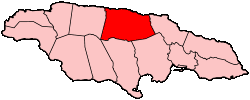
Population (1999): 163,700
Capital: St. Ann's Bay
Major Towns: Ocho Rios, Browns Town, Runaway Bay, Claremont
Area: 1,212.6 sq. km (468.2 sq. miles)

St. Ann is Jamaica’s largest parish, centrally located on the island’s north coast. Known as the “Garden Parish,” it boasts lush landscapes and a notable historical legacy. Significant bauxite and limestone deposits highlight the region’s industrial importance. St. Ann also features the Moneague Lake—a seasonal lake—and the scenic White River, shared with neighboring St. Mary.
The Dry Harbour Mountains, peaking at about 762 meters, dominate the parish’s interior. St. Ann’s limestone foundation has yielded over 50 caves and multiple sinkholes, while its main rivers include the Negro, St. Ann, Great, Roaring, Cave, and Pedro Rivers. This diverse topography underpins the parish’s agricultural, mineral, and tourist activities.
St. Ann stands among the earliest inhabited regions of Jamaica, with Taino/Arawak presence dating as far back as 600–650 A.D., drawn by plentiful freshwater resources. Christopher Columbus made his inaugural landing in present-day Discovery Bay, and the Spanish founded their first Jamaican settlement, Sevilla la Nueva (New Seville), in the area.
After the English gained control of Jamaica in 1655, St. Ann’s Bay developed into a prominent fishing port, while Ocho Rios gradually rose to prominence in the 1960s, bolstered by bauxite mining and growing tourism.
Bauxite Mining:
Discovered in 1942, bauxite mining started a decade later with Reynolds Jamaica Mines Ltd (1953) and later Kaiser Aluminium. Both companies played significant roles in developing local communities and infrastructure.
Tourism:
Ocho Rios and Runaway Bay rank among Jamaica’s premier tourist hotspots, with Ocho Rios a leading port for cruise ships. Tourism remains a major employer and contributes substantially to the parish’s economy.
Agriculture:
Although agriculture has waned over time—giving way to housing and other developments—farmers still grow bananas, coconuts, pimento, and assorted vegetables. Livestock and poultry ventures have also declined.
Manufacturing:
As of 1995, 52 factories operated in St. Ann, producing meats, dairy items, furniture, apparel, and printed products.
Moneague Lake:
This intermittent lake swells and recedes with rainfall and underground water levels. Its habitat supports turtles, perch, and waterfowl, offering a unique natural attraction.
Fern Gully:
A three-mile stretch of roadway near Ocho Rios, originally an old riverbed, now showcases about 200 types of ferns. Though hurricanes and pollution have impacted the area, it remains a protected site known for its verdant foliage.
Marcus Garvey’s Birthplace and Statue:
Located in St. Ann’s Bay, this national monument commemorates Jamaica’s foremost pan-Africanist. The parish library also features a prominent statue in his honor.
Rio Hoe:
Nestled roughly 3.2 kilometers from Moneague, Rio Hoe was among the last Spanish communities on the island.
Columbus Park:
Situated in Discovery Bay, this open-air museum honors Columbus’s arrival in Jamaica. Funded by Kaiser Aluminium, it houses displays and historical insights into early settlement.
Runaway Caves (Green Grotto):
Near Discovery Bay, these extensive limestone caves contain dripstone formations and an underground lake called Green Grotto. Artifacts include Taino rock art, along with historical ties to pirates and Spanish settlers.
Seville Great House and Heritage Park:
Built in 1745, the Great House now forms part of a museum complex detailing Jamaica’s Spanish and British colonial eras.
Edinburgh Castle:
The ruins of an 18th-century fortified estate near Claremont, built by the infamous Scotsman Lewis Hutchinson. Notorious for its dark past, remnants of the castle still endure.
Dunn’s River Falls:
A major tourist draw, these cascading falls stretch 600 feet, inviting visitors to climb in groups. The lush park below leads directly to a sandy beach.
Bob Marley Museum (Nine Mile):
Celebrating the reggae icon’s birthplace and resting place, this museum is operated by the Bob Marley Foundation. It supports local community projects and pays tribute to Marley’s enduring global influence.